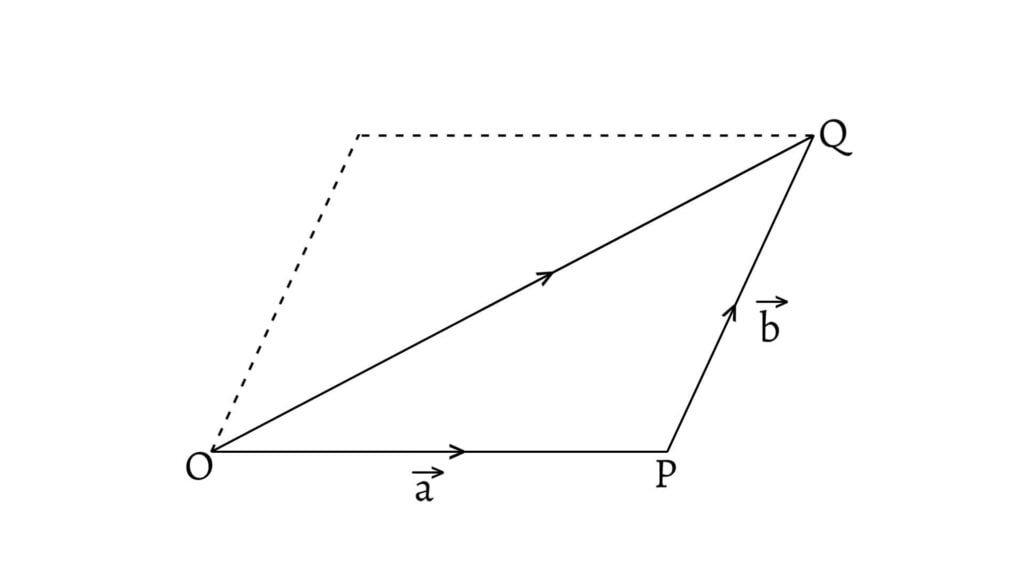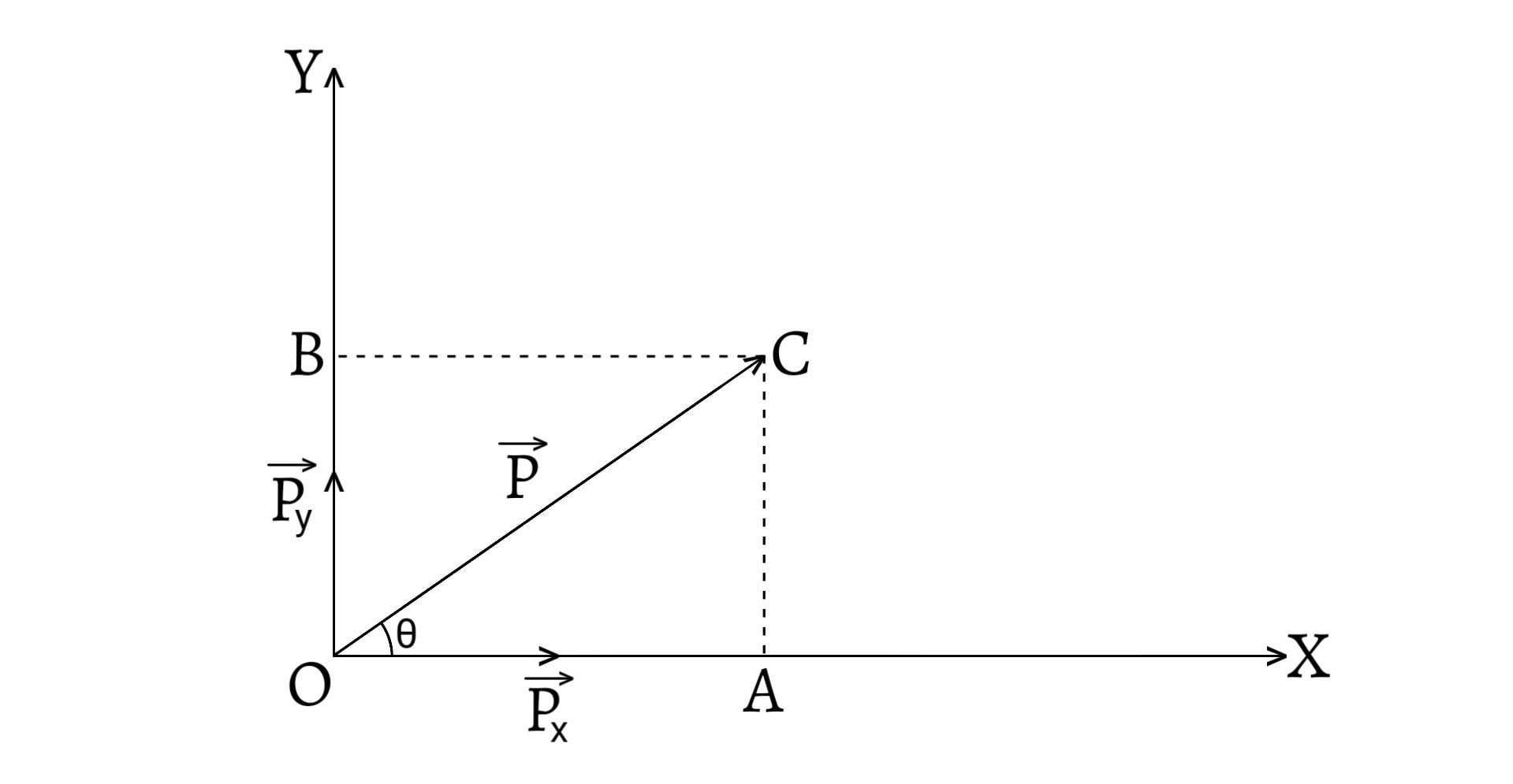Triangle law of vector addition states that if two vectors in magnitude and direction starting from a point represents two sides of a triangle in same order, then, the third side of the triangle taken in reverse order represents the resultant magnitude and direction of the two vectors.
From the parallelogram law of vector addition, we know that the diagonal of the parallelogram represents the resultant of the two vectors represented by its adjacent sides.
Let $\overrightarrow{a}$ and $\overrightarrow{b}$ be any two vectors represented by $\overrightarrow{OP}$ and $\overrightarrow{PQ}$ respectively as shown in the figure given below. Then, $\overrightarrow{OQ}$ is said to be the sum of the two vectors $\overrightarrow{a}$ and $\overrightarrow{b}$ and is written as
\[\overrightarrow{OQ}=\overrightarrow{OP}+\overrightarrow{PQ} =\overrightarrow{a}+\overrightarrow{b}\]

Thus, the sum of the vectors $\overrightarrow{a}$ and $\overrightarrow{b}$ is the vector $\overrightarrow{OQ}$ determined by the diagonal of the parallelogram whose adjacent sides are represented by $\overrightarrow{OP}$ and $\overrightarrow{PQ}$. This is also known as the triangle law of vector addition.
Triangle law of vector addition states that if two vectors acting simultaneously at a point are represented in magnitude and direction by two sides of a triangle taken in same order, then the resultant vector both in magnitude and direction is represented by the closing (or third) side of the triangle taken in reverse order.
Consider two vectors $\overrightarrow{P}$ and $\overrightarrow{Q}$ are represented by two sides $\overrightarrow{AB}$ and $\overrightarrow{BC}$ of a triangle $ABC$. Then, according to the triangle law of vector addition, the third side $\overrightarrow{AC}$ represents the resultant $\overrightarrow{R}$ of those two vectors. Let $\theta$ be the angle between those two vectors.
\[\therefore\overrightarrow{AC} =\overrightarrow{AB}+\overrightarrow{BC}\] \[\overrightarrow{R}=\overrightarrow{P}+ \overrightarrow{Q}\]

Magnitude of Resultant $\overrightarrow{R}$
From $C$, draw $CM$ perpendicular to $AB$, produced upto $M$.
By using Pythagoras theorem in right angled $\Delta AMC$, \[AC^2 = AM^2 + MC^2\] \[AC^2 = (AB + BM)^2+ MC^2 \text{ __(1)}\]
\[\text{and,}\;\sin\theta=\frac{MC}{BC}\] \[\therefore MC=Q\sin\theta \text{ __(2)}\]
\[\text{Similarly,}\;\cos\theta=\frac{BM}{BC}\] \[\therefore BM=Q\cos\theta \text{ __(3)}\]
\[\text{From (1),}\;R^2 = (P + Q\cos\theta)^2+ (Q\sin\theta)^2\] \[R^2 = P^2+ 2PQ\cos\theta + Q^2\cos^2\theta + Q^2\sin^2\theta\] \[R^2= P^2+ 2PQ\cos\theta + Q^2 (\cos^2\theta + \sin^2\theta)\] \[R^2= P^2+ 2PQ\cos\theta + Q^2\] \[\therefore R^2 = \sqrt{P^2 + 2PQ\cos\theta + Q^2}\]
Let the angle of the resultant with $\overrightarrow{P}$ be $\beta$. \[\text{Then,}\;\tan\beta = \frac{MC}{AM}\] \[\tan\beta = \frac{Q\sin\theta}{P+Q\cos\theta}\] \[\therefore\beta = \tan^{-1}\left(\frac{Q\sin\theta}{P+Q\cos\theta}\right)\]
Special Cases
Case I:
When the vectors are parallel to each other, i.e. $\theta=0°$, \[R^2 = \sqrt{P^2 + 2PQcos0 + Q^2}\] \[R^2 = \sqrt{P^2 + 2PQ + Q^2}\] \[R^2 = \sqrt{(P + Q)^2}\] \[∴R = P + Q\;\text{(Maximum value of R)}\]
Case II:
When the vectors are perpendicular to each other, i.e. $\theta=90°$, \[R^2 = \sqrt{P^2+ 2PQcos90 + Q^2}\] \[\therefore R^2 = \sqrt{P^2 + Q^2}\]
Case III:
When the angle between the vectors $(\theta)$ is $180°$. \[\text{Then,}\; R^2 = \sqrt{P² + 2PQcos180 + Q²}\] \[R^2 = \sqrt{P^2 – 2PQ + Q^2}\] \[R^2 = \sqrt{(P – Q)^2}\] \[\therefore R = P – Q\;\text{(Minimum Value of R)}\]
Previous: Parallelogram Law of Vector Addition
Next: Polygon Law of Vectors






